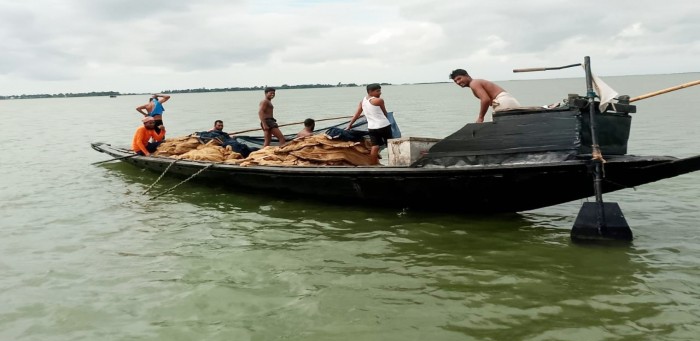News Flash

SUNAMGANJ, Sept 3, 2025 (BSS) – Numerous native fish species in the Sunamganj haor system are facing endangered due to factors like overexploitation through indiscriminate and illegal fishing, habitat degradation from siltation and pollution, blocking of migratory routes, and climate change.
The district is surrounded by haors and once these natural water bodies were full of native fish species. People in a haor ecosystem primarily relied on fishing for their livelihood.
However, fishing without following the rules is hampering the reproduction of native fish. In addition, the adverse effects of the climate change are hampering the reproduction of native fish every year.
Fishermen said that there is a crisis in reproduction of native fish species due to lack of water in the haors during the breeding season, insufficient rains and indiscriminate hunting of mother fish.
Abdur Rahim, a fisherman from Balikandi village in Sadar upazila, said that the demand for local fish is always high but the supply of local fish in the haors is constantly decreasing.
The local markets of the district and upazila are occupied by fish such as pangasius, sing, magur, tilapia, koi and carp cultivated in ponds or enclosures, he said.
However, fishermen said that local fish become available if there is rain. At this time, the haors, canals and rivers are supposed to be full of fish including baghair, rita, queen pangasius, shrimp and other species of local fish.
But none of these fish are available in the water bodies this year.
Construction of unplanned crop protection embankments is another major cause to reduce local varieties of fish in the haors.
Fish trader Mamunur Rashid said that once local fish from the haors were available in the market but now they rely on farmed fish.
Abdul Alim, a fish farmer from Harinapati village in Rangarchar union of Sadar upazila, said that “We are not able to cultivate fish properly in the farm this time due to lack of water and rainfall. New water enters the haors in the months of Boishakh-Jayishtha. At this time, the fish breeding season begins. The eggs of the mother fish hatch and the fry are born. But this time, due to the lack of water, there are no mother fish in the haors.”
Fisherman Abdur Rahim said that the price of fish is high because fish farming is not done like other years. Native fish is very rare.
According to the Sunamganj Fisheries Department, 143 native species and 12 foreign species of fish were once found in the haor. Currently, 64 species of fish are threatened, 9 species of fish are critically endangered, 30 species of fish are endangered and 25 species of fish are in critical condition.
There are 95 haors in Sunamganj, the largest freshwater reservoir in the country.
There are 26 of 105 canals and rivers. The total number of beels and water reservoirs is 1,035 encompassing a total area of 63,666 hectares in the entire district.
Of this, the area of haor is 35,990 hectares and the area of rivers is 6,61.06 hectares. 89.38 percent of fish is produced in the open water bodies of the district annually and 10.62 percent in ponds.
The total annual demand for fish in the entire district is 56,372 metric tons while production is 114,130 metric tons.
There are 101,329 registered and 20,414 unregistered fishermen in Sunamganj. Many of them are not involved in fishing.
The Department of Fisheries Office sources said that due to the fish crisis in the haor, most of the fishermen have moved to other professions. It is known that many species of fish including Mahashol, Sarpunti, Gharua, Baghar, Ritha, Chital, Naftani, Bamosh, Rani, Chaka, Tatkini, Banshpata, Bacha, Dhela, Foli, Darkina, Airh, Pabda, Titpunti, Kalibaus, Nandina, Khash Khaira, Tila Shola, Shalbaim, Ghang Magur, Nama Chanda, Shrimp, Kachki have become endangered and critically endangered levels.
That is, 64 species are under threat, 9 are critically endangered, 30 are endangered, and 25 are critically endangered.
In addition, aquatic life is also in crisis and aquatic plants are on the verge of extinction. The new generation is not getting any idea about these aquatic plants.
Zahur Ali, vice-president of Sunamganj Matsa Samabay Samity, (Sunamganj Fisheries Cooperative Society) said that this time the fish are not able to breed due to lack of water. One reason is the scorching sun and on the other hand, people are not cultivating fish due to the fear of floods.
The reason for the extinction of native fish species is the decreasing the natural water flow in the haors. The sand is filling up the ponds, wetlands and agricultural land.
District Fisheries Officer Shamshul Karim said that the shortage of water in the haors at the right time, weather and climate change have led to a crisis in native fish species in the haors.
Deputy Commissioner Dr. Mohammad Ilias Mia said, “I cannot see the diversity of fish this year that I saw the last year. Native fish is decreasing due to untimely rainfall, filling of rivers and streams, and indiscriminate killing of fish.